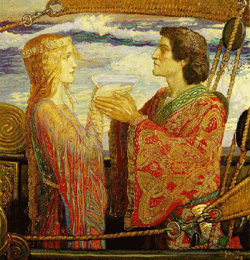
The Myth of Tristan and Isolde(continued)
By Tala Bar
Besides the outline of the legend of Tristan and Isolde, which presents a basic, ancient Sun myth, there are other, numerous, mythical elements in it. The first and one of the most important ones is the figure of Tristan's mother. Like many other mythological female characters, she is a princess — actually, sister to the Sun King Mark, in the same way that the (white) Moon Goodess Artemis was sister to the Sun God Apollo. (This kind of relationship shows a removal from an older stage in pagan religion, when the Goddess had no male relations beside her son/lover). The name of Tristan's mother is Blanchfleur, meaning "white flower." She is, in fact, the great Mother Goddess, of whom Robert Graves talks about in The White Goddess, and to whom all white flowers were sacred. Such Mother Goddesses were Hera, mother of the gods, and her pear blossom; Aphrodite, mother of Eros, and her myrtle flowers; Nana (again), and her almond blossom, and others like them. Blanchfleur, the mother of the Sun God, was a parallel to the Egyptian goddess Isis, who was the mother of the Sun God Horus.
But the Goddess of Nature in her entirety takes the form of a Triad: she is the Sun's Mother, born at the beginning of the year. She is his young Bride when the Sun gets strong in spring and summer. And she is his Killer when his time comes at the end of the year. This Triple Goddess is represented in the story of Tristan and Isolde in the triple figure of Isolde: the young Golden-Haired bride; her mother, Queen Isolde of Ireland; and his killer, Black Isolde of Bretany. Young Isolde is forever the Goddess of Love. Even after years of marriage to Mark, and out of her love for Tristan she comes out to where he lies wounded to try and cure him. But she does not succeed in this last function, because it does not belong to her but to her mother, Queen Isolde, who has cured him twice. In contrast, Black Isolde causes Tristan's death in the following fashion: though young Isolde has caused white (or blue) sails to be put on the mast of the boat in which she is coming to heal him, his traitorous wife tells him they are black, thus making him die, not of his wounds but of sorrow, as he should do, according to his name and function. True to her nature as a figure of love, young Isolde dies with him, even though she could not live with him; in this way she initiates a new outlook of the Goddess' funcion, for, although there is a Mother Goddess as the figure of Mary in Christianity, this new religion recognizes no Goddess of Love.
Another mythological element in the story requires special attention. This is the dragon, which has devastated Ireland and which Tristan vanquishes and thus saves the land and its inhabitants. The dragon has been considered the enemy of European heroes since the Greek Perseus saved Andromeda opposite the shore of Canaanite Jaffa (or Ethiopian Joppa).
Now, in the ancient Middle and Far East, the dragon was not the evil flame-thrower as shown by Medieval Europeans, but a figure of the mostly benevolent Mother Goddess, ruler of all waters in dry areas, where water is scarse and of prime importance. The first divine hero to vanquish that dragon was the Babylonian Marduch, who killed his own mother Tiamat (Tehom in Hebrew, meaning "the source of underground waters") and build the earth from her body; which is absurd, because Tiamat was herself Mother Earth who had given birth to all life on it.
The symbolic meaning of that ancient myth is the replacement of the old Mother Nature religion and the rule of female compassion with the new young god and the rule of male physical power. On these lines, Graves assumes the dragon Perseus killed was not going to devour Andromeda — who was a figure of the ancient Goddess as a young female — but was "an emanation of Andromeda herself as the ancient Mother Goddess." Here again is the young male vanquishing the old female for the sake of a new human social order, as happened when St. George killed his dragon, thus vanquishing the remnants of the old pagan religion from Christian Medieval Europe. The Tristan legend (not the ancient myth) acts here as a parallel to St. George's, repeating Marduch's action out of context.
The old myth has turned into a legend when trappings of all kinds were attached to it, and the basic mythical symbolism was forgotten, together with the religious fertility rituals. Instead of giving meaning to the wanderings of the sun and the circular seasons of life, which is the essence of the myth, the central place was given to the hopeless love between hero and goddess, in the tradition of the French romance. The essence of the romance was the love of a humble knight to some courtly mistress (or "courtesan"), who was unreachable like a goddess because she stood high above him in society, and was married as well. Wagner's opera enhances this emotional conflict, while modern poetry sresses the beauties and misery of personal love, with no connection to the framework of the tale.
So, although the meaning of the ancient myth has been forgotten, the greatness of the story of Tristan and Isolde is in the way it can speak in different languages in various places and times; and the way it presents different meanings to different people, always concentrating on the main theme, which is love.